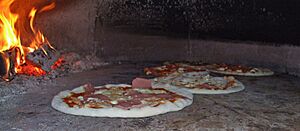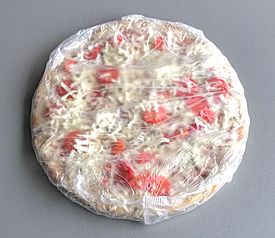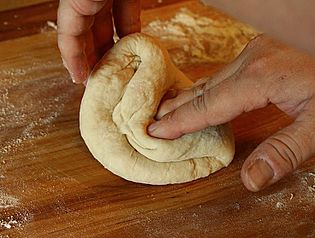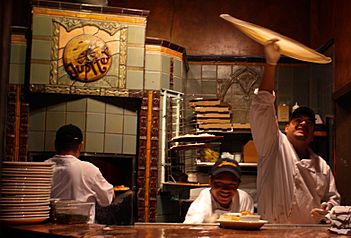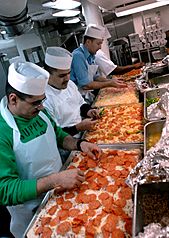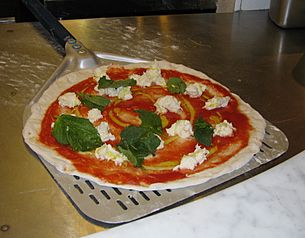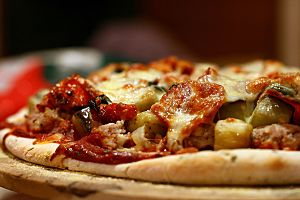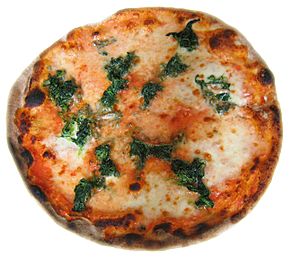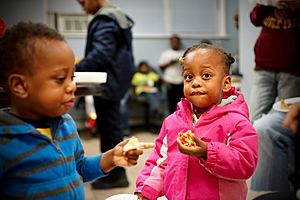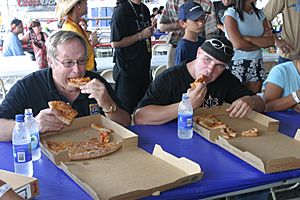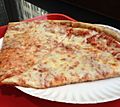Pizza facts for kids
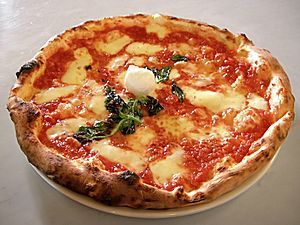
Pizza Margherita, the archetype of Neapolitan pizza
|
|
| Type | Flatbread |
|---|---|
| Course | Lunch or dinner |
| Place of origin | Italy |
| Region or state | Campania (Naples) |
| Serving temperature | Hot or warm |
| Main ingredients | Dough, sauce (usually tomato sauce), cheese |
| Variations | Calzone, panzerotti, stromboli |
Pizza is a super popular food that started in Italy. It's basically a flat piece of bread (called a crust) covered with sauce, usually tomato sauce, and then topped with yummy things. These "toppings" can be anything from cheese and pepperoni to vegetables and spices. People all over the world enjoy pizza, and the toppings they choose can be very different! Pizza first came from Naples, Italy, but now it's loved everywhere.
Contents
The Story of Pizza: A Delicious History
The exact start of the word Pizza is a bit of a mystery. This special flatbread was first made in Naples, Italy, about 200 years ago. It's made with a unique kind of dough. Pizza became even more famous when it traveled to the United States in the late 1800s.
Flatbreads, like the focaccia from Liguria, have been around for a very long time. To bake pizzas properly, you need really hot ovens, about 200-250°C. Most homes didn't have ovens that hot back then. So, people would make the pizza dough at home and then take it to the town bakery to be baked.
In June 1889, a chef from Naples named Raffaele Esposito made a special pizza. He created it to honor Queen Margherita. This "Margherita" pizza was the first to include cheese, making it extra special!
Pizza Comes to America
Italian immigrants brought pizza to the United States in the late 1800s. It first appeared in places where many Italian immigrants lived. The very first pizzeria in the U.S., called Lombardi's, opened in 1905.
After World War II, many soldiers who had been in Italy came home. They had tasted pizza there and wanted more! This helped pizza become super popular across the U.S. Today, big pizza chains like Domino's, Pizza Hut, and Papa John's have restaurants everywhere. About 13% of people in the U.S. eat pizza every single day!
Making Pizza: From Dough to Deliciousness
You can find pizza fresh, frozen, or even as single slices. People have found clever ways to make frozen pizzas that taste great when you heat them up. Some frozen pizzas even have raw ingredients and crusts that rise while they bake!
You can also buy uncooked pizza from "take and bake" pizzerias. You buy it assembled, then bake it at home in your own oven. Some grocery stores even sell fresh dough, sauce, and toppings so you can make your own pizza from scratch.
- Pizza preparation
-
A wrapped, mass-produced frozen pizza to be cooked at home
-
Pizza dough being kneaded. After this, it is typically left undisturbed and allowed time to proof.
Cooking Pizza: Hot and Ready
In restaurants, pizza can be baked in different kinds of ovens. Some use ovens with stone bricks, others use electric ovens or conveyor belt ovens. The fanciest restaurants might even use wood or coal-fired brick ovens.
Chefs use a long paddle called a peel to slide pizzas into these hot ovens. Sometimes, they sprinkle cornmeal on the peel to help the pizza slide off easily. If you make pizza at home, you can use a pizza stone in your regular oven. This helps make the crust crispy, like in a brick oven.
Some home chefs even have special wood-fired pizza ovens outside. These dome-shaped ovens have been used for hundreds of years to cook pizzas perfectly. Another way to cook pizza is on a barbecue grill! This is called grilled pizza.
- Pizza cooking
-
Pizzas bake in a traditional wood-fired brick oven
Pizza Crust: The Base of the Bite
The bottom part of the pizza is called the "crust." It can be very thin, like a traditional Neapolitan pizza, or super thick, like a deep-dish Chicago-style pizza. The crust is usually plain, but sometimes it's flavored with garlic or herbs, or even stuffed with cheese! The outer edge of the pizza is sometimes called the cornicione.
Did you know that dipping sauce for pizza was invented by the American pizza chain Papa John's Pizza in 1984? Now, it's super popular, especially for dipping the crust!
Pizza Cheese: Melty Goodness
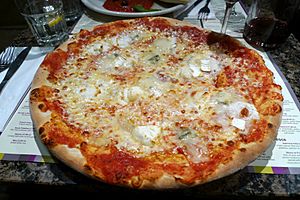
Mozzarella is the most common cheese used on pizza. The best quality mozzarella, called buffalo mozzarella, comes from around Naples. But many other Italian cheeses are also used, like provolone, pecorino romano, ricotta, and scamorza.
For mass-market pizzas, less expensive cheeses are often used. These are made to melt perfectly, stretch nicely, and stay fresh for a long time. Making the perfect pizza cheese has involved lots of studies and experiments! In 1997, people estimated that over 1 million tons of pizza cheese were made in the U.S. each year.
Pizza Around the World: Different Styles
Italian Pizza Styles
Real Neapolitan pizza (pizza napoletana) is made with special San Marzano tomatoes and mozzarella di bufala Campana. This mozzarella comes from water buffalo in Italy and has a special protected status.
Other traditional Italian pizzas include pizza alla marinara, which has marinara sauce and is thought to be the oldest tomato-topped pizza. There's also pizza capricciosa, made with mozzarella, ham, mushrooms, artichokes, and tomato. Pizza pugliese has tomato, mozzarella, and onions.
A popular type of pizza in Italy is Sicilian pizza (called sfincione or sfinciuni). This is a thick-crust or deep-dish pizza that started in Sicily in the 1600s. It's like a focaccia bread, usually topped with tomato sauce and other ingredients. In Turin, you can find pizza al padellino, which is a small, thick-crust, deep-dish pizza.
United States Pizza Styles
As we learned, 13% of people in the U.S. eat pizza every day! Big pizza chains, take-and-bake pizzerias, and frozen pizzas from supermarkets make it easy to find pizza everywhere.
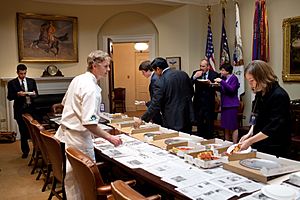
Common toppings in the U.S. include ground beef, mushrooms, onions, pepperoni, pineapple, garlic, olives, and many more. Over the years, different regions in the U.S. have created their own unique pizza styles. These include California, Chicago, Detroit, Greek, New Haven, New York, and St. Louis styles.
The first pizzeria in the U.S. opened in New York in 1905. Since then, you can find all sorts of variations, like deep-dish, stuffed pizzas, and even pizza-on-a-stick!
Another fun type is grilled pizza. This is made by putting a thin pizza dough directly on a barbecue grill. Once one side is baked, you flip it, add toppings to the cooked side, and finish grilling. Toppings are often sliced thin so they cook quickly. Grilled pizza became popular in the U.S. in the 1980s.
Argentine Pizza Styles
Argentina, especially Buenos Aires, saw many Italian immigrants in the early 1900s. They opened the first pizza places.
Argentine pizza usually has a thicker crust, called "media masa" (half dough), than traditional Italian pizza. It also has more cheese! In Argentina, people often eat pizza with fainá, which is a chickpea-flour dough placed on top of the pizza, and moscato wine.
The most popular pizza in Argentina is called "muzzarella." It's like a Neapolitan pizza (bread, tomato sauce, and cheese) but with a thicker crust, lots of cheese, and usually olives. You can find it almost everywhere in Argentina. Buenos Aires is even said to have the most pizza places per person in the world!
Two very popular Argentine pizzas with onion are fugazza with cheese and fugazzetta. Fugazza with cheese has a regular pizza crust with cheese and onions on top. Fugazzetta has cheese between two pizza crusts, with onions on the top.
Pizza Records: Big and Pricey
The world's largest pizza was made in Rome in December 2012. It was huge, measuring about 1,261 square meters (that's bigger than two basketball courts!). This pizza was named "Ottavia" and had a gluten-free base.
The world's longest pizza was made in Fontana, California, in 2017. It stretched for about 1,930 meters, which is over a mile long!
The most expensive pizza officially recognized by Guinness World Records costs £100 (about $125 USD). It's a thin-crust pizza from a restaurant in London. It's baked in a wood fire and topped with fancy ingredients like white truffle paste, special cheeses, bacon, mushrooms, and fresh wild lettuce.
There have been even more expensive pizzas, like one that cost £4,200 (about $5,300 USD) with caviar, lobster, and 24-carat gold dust! Another one, for charity, sold for £2,150 (about $2,700 USD) and had smoked salmon, venison, edible gold, and champagne-soaked caviar. These aren't in the Guinness World Records, though.
In 2017, the global pizza market was worth $128 billion! In the U.S. alone, it was $44 billion, with over 76,000 pizzerias.
Pizzerias: Where Pizza is Made

Antica Pizzeria Port'Alba in Italy started making pizzas in 1738 and is still serving them today! It's one of the oldest pizzerias in the world.
Some of the biggest global pizza chains you might know are Pizza Hut, Domino's Pizza, Cici's Pizza, Papa John's, and Little Caesars.
Frozen Pizza: Quick and Easy
Frozen pizza is pizza that's made ahead of time and then frozen. You can buy it in supermarkets and bake it at home. It's one of the most popular types of convenience food because it's so quick and easy to prepare.
Pizza in Pop Culture
Did you know that Macaulay Culkin (the actor from Home Alone) started a band in 2012 that makes songs about pizza? It's called The Pizza Underground!
See also
 In Spanish: Pizza para niños
In Spanish: Pizza para niños
Images for kids
-
Home-made Neapolitan-style pizza with cheese and toppings
-
Caramelised crust – its cornicione (the outer edge) – of slices of New York-style pizza
-
Charred crust on a Pizza Margherita, an acceptable trait in artisanal pizza
-
A vegetarian pizza
-
Garlic fingers, the archetype of Canadian pizza
-
A hamburger pizza served at a Kotipizza restaurant in Finland
-
Argentine fugazzetta.


